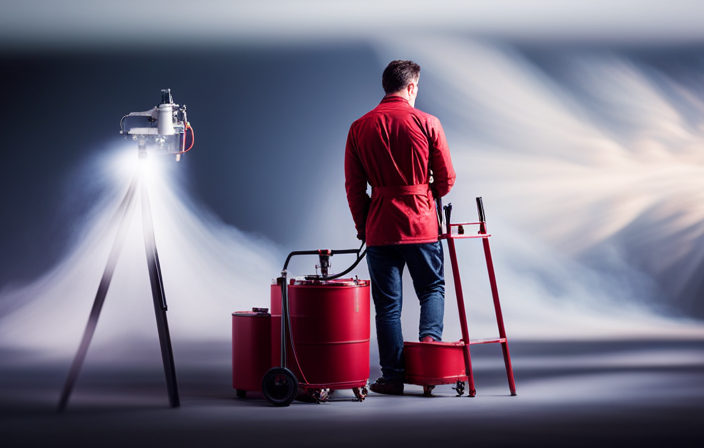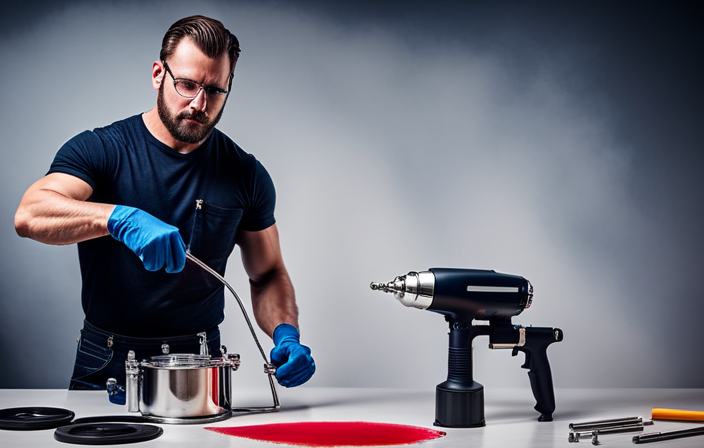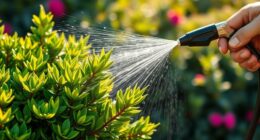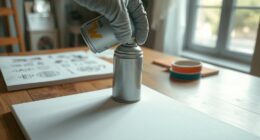I recall the initial moment of realization when I first encountered the magic of utilizing an airless paint sprayer. It was truly a game-changer, offering a convenient way to achieve perfectly smooth and even finishes in no time. However, as I delved further into the realm of airless paint sprayers, I started pondering: how long can paint sit in an airless sprayer before encountering problems? This query is a frequent worry for both DIY enthusiasts and experts alike.
In this article, we will explore the various factors that affect the shelf life of paint in an airless sprayer. From understanding paint degradation to extending its lifespan, we’ll cover it all.
We’ll also discuss the telltale signs of paint gone bad and offer tips for efficient paint usage. Plus, we’ll delve into the best practices for cleaning the sprayer to ensure its longevity.
So, if you’ve ever wondered about the shelf life of paint in an airless sprayer, join me on this informative journey as we uncover the answers and become masters of paint preservation.
Key Takeaways
- Paint left in an airless sprayer can undergo chemical reactions like oxidation, leading to degradation in quality and changes in color, texture, and overall performance.
- Proper storage in sealed containers, away from air and moisture, helps prevent chemical reactions and maintain the desired color and texture of the paint.
- Exposure to extreme temperatures can negatively impact paint quality, resulting in poor coverage at high temperatures and thicker, harder-to-spray paint at low temperatures.
- Regular cleaning and maintenance of the airless sprayer, including flushing with water or cleaning solution after each use, inspecting and replacing worn parts, and using a filter to remove debris, are essential for optimal performance and prolonging the sprayer’s lifespan.
Factors Affecting Paint Shelf Life in an Airless Sprayer
The shelf life of paint in an airless sprayer can be influenced by several factors. One important factor is the viscosity of the paint. If the paint becomes too thick or too thin, it may not spray properly and could lead to clogs or uneven coverage. Factors affecting paint viscosity include the type of paint, the ratio of paint to thinner, and the temperature at which the paint is stored.
Speaking of temperature, it also plays a significant role in the shelf life of paint in an airless sprayer. Extreme temperatures can cause the paint to degrade more quickly, leading to changes in color, texture, and overall quality. It’s important to store paint in a cool, dry place to extend its shelf life.
Understanding paint degradation and how to prevent it is crucial for maintaining the quality of the paint and achieving optimal results.
Understanding Paint Degradation
When it comes to paint degradation, there are several key points to consider.
Firstly, chemical reactions can occur over time, causing the paint to break down and lose its effectiveness.
Secondly, color and texture changes may occur, leading to an undesirable finish.
Finally, paint degradation can result in decreased performance, such as reduced coverage or adhesion.
Understanding these factors is crucial in maintaining the quality and longevity of paint in an airless sprayer.
Chemical Reactions
After a while, paint left in an airless sprayer may start to undergo intriguing chemical reactions. These reactions occur due to the exposure of the paint to air and other elements present in the environment.
One common reaction is oxidation, where the paint molecules react with oxygen in the air, leading to the formation of new compounds. This can result in changes in the paint’s properties, such as its color and texture.
Additionally, some paint ingredients may interact with each other, causing chemical reactions that alter the paint’s composition.
To prevent these reactions, it’s important to properly store paint in sealed containers and avoid leaving it in an airless sprayer for extended periods. By doing so, you can maintain the desired color and texture of your paint for future use.
Color and Texture Changes
Storing paint in sealed containers can help preserve its color and texture, preventing any unwanted surprises down the road. Over time, exposure to air and other environmental factors can cause color fading and texture inconsistencies in paint. Color fading occurs when the pigments in the paint are exposed to light and begin to break down. This can result in a loss of vibrancy and intensity in the color. Texture inconsistencies can occur when the paint dries unevenly or when the particles in the paint settle over time. This can lead to an uneven, rough, or grainy finish. It is important to properly store paint and use it within its recommended shelf life to avoid these issues. Ensuring proper storage conditions and using fresh paint can help maintain the desired color and texture. Moving on to the next section, decreased performance can also be a concern when paint is left in an airless sprayer for too long.
Decreased Performance
To make sure your paint performs at its best, be mindful of how it’s handled and the duration it spends in the sprayer. Factors causing paint degradation include exposure to air, moisture, and contaminants. These can lead to color and texture changes, as well as decreased performance.
Temperature also plays a crucial role in paint performance. High temperatures can cause the paint to dry too quickly, resulting in poor coverage and an uneven finish. Conversely, low temperatures can make the paint thicker and more difficult to spray effectively. It’s important to store the sprayer in a cool, dry place to minimize these effects.
By understanding the factors that affect paint performance, you can extend the shelf life and ensure optimal results.
Extending the Shelf Life of Paint
If you want to keep your paint fresh for longer, make sure to store it in a cool, dry place away from direct sunlight. This will help maximize efficiency and prevent paint waste. Additionally, there are a few other steps you can take to extend the shelf life of your paint. Firstly, make sure the lid is tightly sealed to prevent air from entering the container. Secondly, consider adding a paint preservative to the can, which can help prevent the growth of mold and bacteria. Lastly, avoid exposing the paint to extreme temperatures, as this can cause it to deteriorate more quickly. By following these guidelines, you can ensure that your paint will remain in good condition for an extended period of time. Speaking of which, let’s now discuss the signs of paint gone bad.
Signs of Paint Gone Bad
Don’t be surprised if your once-vibrant paint has transformed into a monstrous concoction of clumps and curdled colors, a sight that would make any DIY enthusiast shudder in horror. Proper paint storage is crucial to maintaining its quality and preventing it from going bad. Paint, just like any other product, has an expiration date. Exposure to extreme temperatures, moisture, and air can accelerate the deterioration process. To ensure the longevity of your paint, follow these tips:
- Store paint in a cool, dry place away from direct sunlight.
- Seal the paint can tightly to prevent air and moisture from entering.
- Avoid storing paint cans upside down, as this can lead to the formation of a thick skin on the surface.
Testing the paint’s viability is the next step in determining whether it’s still usable or not.
Testing the Paint’s Viability
Now, let’s find out if your paint is still good to use by testing its viability. There are several testing methods you can use to determine if your paint has gone bad. One method is to check for any changes in the paint’s consistency, such as clumps or separation. You can also perform a smell test to see if the paint has developed a foul odor. Additionally, you can apply a small amount of the paint onto a test surface and observe if it dries properly and adheres well. It’s important to note that the viability of the paint can also be influenced by storage conditions. Extreme temperatures and exposure to sunlight can cause the paint to deteriorate more quickly. If your paint is no longer viable, it’s essential to dispose of it properly to avoid environmental contamination.
Proper Disposal of Expired Paint
When it comes to the proper disposal of expired paint, there are several key points to consider.
First and foremost is the environmental impact of disposing of paint improperly. It’s important to be aware of local regulations and guidelines for disposing of paint, as different areas may have different rules.
Finally, it’s worth exploring recycling and reusing options for expired paint, as this can be a more sustainable and environmentally friendly solution.
Environmental Impact
Contrary to popular belief, leaving paint in an airless sprayer for an extended period can have a significant environmental impact. Each gallon of wasted paint contributes to an estimated 13.6 pounds of hazardous waste.
This waste not only pollutes our landfills, but it also has a harmful impact on air quality. When paint is left in the sprayer, it can dry up and release harmful volatile organic compounds (VOCs) into the air. These VOCs contribute to the formation of smog and can harm human health.
To minimize the environmental impact of paint disposal, it’s important to consider eco-friendly alternatives such as donating unused paint or properly recycling it. Local regulations often dictate the correct disposal methods, ensuring that paint is handled responsibly and does not harm the environment.
Local Regulations
When it comes to the environmental impact of leaving paint in an airless sprayer, it’s important to consider local regulations and proper disposal methods. Different areas may have specific rules and guidelines regarding the handling and disposal of paint, as well as other hazardous materials. It’s crucial to follow these regulations to ensure that paint waste is disposed of properly and does not harm the environment.
One option for proper disposal is to take the paint to a local recycling center or hazardous waste facility, where it can be processed and disposed of safely. Another option is to donate unused paint to community organizations or individuals in need. By adhering to local regulations and implementing proper disposal methods, we can minimize the environmental impact of leaving paint in an airless sprayer.
In the next section, we will explore recycling and reusing options for leftover paint.
Recycling and Reusing Options
If you’re looking for ways to be eco-friendly with your leftover paint, there are some great options for recycling and reusing it.
When it comes to recycling options, many communities have paint recycling programs where you can drop off your unused paint for proper disposal. These programs ensure that the paint is recycled or disposed of in an environmentally friendly way.
Another option is to donate your leftover paint to local community organizations, schools, or art programs that may have a use for it.
If recycling isn’t an option, you can also consider reusing the paint for touch-ups or small projects around your home.
By finding creative ways to repurpose your leftover paint, you can reduce waste and contribute to a more sustainable future.
Now, let’s move on to some tips for efficient paint usage.
Tips for Efficient Paint Usage
When it comes to efficient paint usage, there are three key points to keep in mind:
-
Planning and calculating quantities: By carefully planning and calculating the amount of paint needed for a project, you can avoid unnecessary waste and save both time and money.
-
Using paint strainers: Using paint strainers is essential for ensuring a smooth and even finish. They help remove any debris or impurities that may be present in the paint.
-
Cleaning and maintaining the sprayer: Regular cleaning and maintenance of the sprayer will not only extend its lifespan, but also ensure optimal performance and prevent any clogs or blockages.
Planning and Calculating Quantities
Calculating the right amount of paint for your project can be a breeze with proper planning and some quick math. To ensure you have enough paint, here are some planning techniques and estimating quantities tips to consider:
-
Measure the surface area: Start by measuring the length and width of the area you plan to paint. Multiply these measurements to get the total square footage.
-
Consider the number of coats: Decide how many coats of paint you’ll need. Multiply the square footage by the number of coats to estimate the total paint needed.
-
Account for waste: Add a little extra paint to account for touch-ups, mistakes, or future repairs.
-
Know the coverage rate: Check the paint can for the coverage rate per gallon. Divide the total square footage by the coverage rate to determine the number of gallons needed.
-
Consult a professional: If unsure, consult with a paint professional who can provide more accurate estimates.
Planning and calculating quantities is crucial for a successful painting project. Once you have the right amount of paint, the next step is using paint strainers.
Using Paint Strainers
To ensure a smooth and flawless finish, strain your paint using paint strainers. Paint strainers are essential tools that help remove any impurities or debris from the paint, ensuring a clean application.
The benefits of using paint strainers are numerous. Firstly, they prevent clogs and blockages in the spray gun, which can result in uneven spraying and wasted paint. Additionally, paint strainers help to eliminate any particles that may cause imperfections on the painted surface, such as dust or dried paint flakes.
There are various types of paint strainers available, including mesh filters, cone filters, and bag filters. Each type is designed to cater to different paint thicknesses and preferences.
Now that you understand the importance of paint strainers, let’s move on to the next section about cleaning and maintaining the sprayer.
Cleaning and Maintenance of the Sprayer
After straining your paint with a paint strainer, it’s important to regularly clean and maintain your sprayer for optimal performance. Cleaning equipment and preventing clogs are crucial to ensure smooth operation and prevent any damage to the sprayer. To maintain your airless sprayer, follow these steps:
| Cleaning | Maintenance | Preventing Clogs |
|---|---|---|
| Flush the sprayer with water or cleaning solution after each use | Check and replace worn or damaged parts regularly | Use a filter to remove debris and impurities from the paint |
| Clean the gun and nozzle using a brush or solvent | Lubricate moving parts to minimize friction | Avoid using paint that has not been properly strained |
| Remove any dried paint from the sprayer components | Store the sprayer in a clean, dry area | Regularly inspect and clean the intake valve and hose |
By regularly cleaning and maintaining your sprayer, you can extend its lifespan and ensure consistent, high-quality results. In the next section, we will discuss common mistakes to avoid when using an airless sprayer.
Common Mistakes to Avoid
Watch out for these common mistakes you might be making when using an airless sprayer to avoid any issues with leaving paint in it for too long. One of the biggest mistakes is improper paint storage. It’s important to store your paint properly, in a cool and dry place, to prevent it from drying out.
Another mistake to avoid is leaving paint in the sprayer for an extended period without proper maintenance. If paint is left sitting in the sprayer for too long, it can clog the nozzle and other components, causing issues with the sprayer’s performance. To prevent this, always clean the sprayer after each use and flush it with water or a cleaning solution.
By following these best practices for cleaning the sprayer, you can ensure its longevity and optimal performance.
Best Practices for Cleaning the Sprayer
When it comes to cleaning the sprayer, there are a few best practices that I always follow.
First, I make sure to flush the sprayer with solvents to remove any remaining paint. This helps to prevent clogs and ensures that the sprayer is ready for the next use.
Next, I carefully remove any excess paint from the equipment, paying close attention to all the nooks and crannies.
Finally, I make sure to properly store the cleaned equipment to prevent any damage or contamination.
These steps may seem small, but they make a big difference in keeping the sprayer in top shape and ensuring optimal performance.
Flushing with Solvents
Before you begin flushing the airless sprayer with solvents, consider how long the paint has been sitting in the sprayer, as this can impact the effectiveness of the flushing process. The longer the paint sits in the sprayer, the more difficult it can be to clean. Flushing the sprayer with solvents is an effective technique for removing any residual paint and ensuring the sprayer is ready for future use. However, if the paint has been sitting in the sprayer for an extended period of time, alternative cleaning methods may be necessary. The table below provides a comparison of flushing techniques and alternative cleaning methods.
| Flushing Technique | Alternative Cleaning Method |
|---|---|
| Solvent flushing | Disassembly and manual cleaning |
| Water flushing | Pressure washing |
| Air flushing | Brush and scraper |
| Dual flushing | Chemical paint removers |
Considering the duration of the paint in the sprayer, it is crucial to choose the appropriate cleaning approach. Once the excess paint is removed, we can move on to the next step of removing any remaining paint residue.
Removing Excess Paint
Once the excess paint’s been removed, it’s time to tackle any remaining residue. To ensure a thorough clean, follow these cleaning techniques:
-
Use a soft cloth or sponge soaked in warm, soapy water to gently scrub the surfaces of the airless sprayer. Pay close attention to areas where paint residue may be trapped, such as around the nozzle or inside the paint container.
-
For stubborn residue, consider using a paint remover specifically designed for the type of paint you were using. Apply the remover according to the manufacturer’s instructions and use a clean cloth or brush to scrub away the residue.
-
Rinse the sprayer thoroughly with clean water to remove any remaining soap or paint remover.
By removing paint residue using these cleaning techniques, you can ensure that your airless sprayer is ready for proper storage of cleaned equipment.
Proper Storage of Cleaned Equipment
After removing excess paint from the airless sprayer, it’s crucial to properly store the cleaned equipment to ensure its longevity and prevent any issues in future use. One important step in this process is allowing the equipment to dry thoroughly before storing it. This helps to prevent any moisture from causing damage or rusting the parts.
Additionally, it’s important to clean and inspect all filters, tips, and hoses to ensure they’re free from any paint residue that could lead to clogs.
Properly storing the cleaned equipment in a cool and dry environment is also essential to maintain its functionality. By following these steps, you can ensure that your airless sprayer remains in optimal condition and ready for use whenever you need it.
Now, let’s address some frequently asked questions about paint shelf life in airless sprayers.
Frequently Asked Questions about Paint Shelf Life in Airless Sprayers
Don’t underestimate the potential of paint shelf life in airless sprayers – it’s vital to know how long you can rely on it for optimal performance. The factors affecting paint shelf life are crucial to understand.
Paint degradation can occur due to various factors, such as exposure to extreme temperatures, moisture, and air. These elements can cause the paint to thicken, separate, or lose its pigmentation over time.
To prevent this, it’s important to store the paint properly in a cool, dry place, away from direct sunlight. Additionally, regular maintenance and cleaning of the airless sprayer can help prolong the shelf life of the paint.
By properly understanding these factors and taking the necessary precautions, you can ensure that your paint will stay in good condition and provide excellent results when used with an airless sprayer.
Frequently Asked Questions
Can I mix different types of paint in an airless sprayer?
Yes, you can mix different types of paint in an airless sprayer. However, it is important to properly clean the sprayer after use to prevent clogs and maintain optimal pressure settings.
Can I use expired paint in an airless sprayer?
Using expired paint in an airless sprayer is like using stale ingredients in a recipe. It won’t perform well and may clog the sprayer. Recycle expired paint instead to ensure a smooth and efficient painting process.
Can I leave the paint in the airless sprayer overnight?
To properly clean an airless sprayer after use, it is important to follow these steps: flush the system with clean water, remove the filters and clean them thoroughly, and lubricate the pump. Additionally, to prevent clogs and blockages, make sure to strain the paint before pouring it into the sprayer and regularly check and clean the spray tip.
Can I store the airless sprayer with paint inside?
Storing paint in an airless sprayer for extended periods can pose hazards, such as paint drying and clogging the system. It’s crucial to clean and maintain the sprayer properly to prevent these issues.
Can I thin the paint before using it in an airless sprayer?
Yes, you can thin the paint before using it in an airless sprayer. Thinning techniques vary based on the paint brand, but it’s important to find the right balance for optimal spraying performance.
Conclusion
In conclusion, it’s crucial to understand the factors that affect the shelf life of paint in an airless sprayer. By taking proper care of the paint and the sprayer, you can extend the lifespan of your paint and ensure optimal performance.
Remember, signs of paint gone bad should never be ignored, and testing the viability of the paint is essential before use. By following these best practices and avoiding common mistakes, you can achieve efficient paint usage and maintain the longevity of your airless sprayer.
So, let your paint shine and let your creativity flow!










